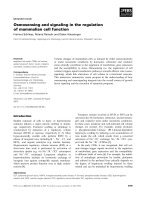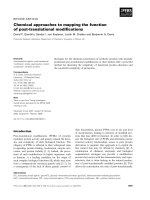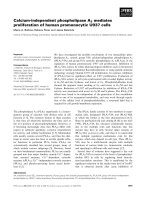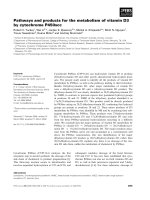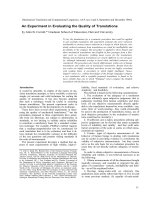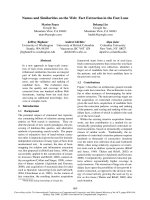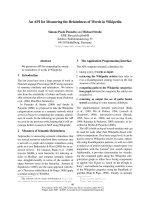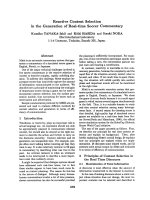Báo cáo khoa học: "French multicentre survey on the use of inotropes after cardiac surgery" pptx
Bạn đang xem bản rút gọn của tài liệu. Xem và tải ngay bản đầy đủ của tài liệu tại đây (177.72 KB, 2 trang )
241
CPB = cardiopulmonary bypass; LCOS = low cardiac output syndrome.
Available online />Abstract
Results from a French multicentre survey on the use of inotropes
after cardiac surgery are presented. Consideration of these
findings, which strictly apply only to France, highlights the
importance of developing monitoring strategies to help in decision
making regarding therapy with inotropes in this context.
During the postoperative period after weaning from
cardiopulmonary bypass (CPB), patients are at increased risk
for developing a low cardiac output syndrome (LCOS).
Despite the availability of a wide range of inotropic agents, no
consensus exists regarding the treatment of LCOS after
CPB. In this issue of Critical Care, Gillies and coworkers [1]
review the literature systematically in order to identify, present
and classify the evidence regarding choice of inotropic drugs.
They observe that insufficient data exist to allow selection of a
specific inotropic agent in preference over another in adult
cardiac surgery patients; that inodilators such as dobutamine
and phosphodiesterase inhibitors are efficacious in the
management of LCOS; that, although all β-agonists can
increase cardiac output, the best studied β-agonist and the
one with the most favourable side effect profile appears to be
dobutamine; and that phosphodiesterase inhibitors increase
the likelihood of successful weaning from CPB as compared
with placebo. The authors suggest that multicentre
randomized controlled trials focusing on clinical outcomes
are needed.
Several comments can be made regarding these important
observations. First, the pathophysiology of the underlying
cardiac failure (e.g. dilatation, obstruction, associated right
heart failure) may impede inotropic effects and therefore
influence the choice regarding intropic therapy. Second,
although not covered by Gillies and coworkers, combination
treatments are often employed in clinical practice and can
involve either inodilators or inoconstrictors; a thorough
assessment of the effects of such combinations remains to
be conducted. Finally, those conducting multicentre
randomized controlled trials to clarify the rationale for use of
inodilators, potentially combined with inoconstrictors, should
carefully consider which monitoring technique is best.
We recently obtained results from a French multicentre
survey into the use of inotropes after cardiac surgery (O
Bastien, unpublished data) that may shed some light on these
issues. The survey was conducted using a questionnaire,
which was sent to participating medical centres. Information
on a prospective minimum cohort of 15 patients per centre
(age >18 years and undergoing cardiac surgery) was
anticipated over a maximum period of 1 month. The main
objectives were to determine the rate of use of inotropes in
LCOS following cardiac surgery, and to identify the
diagnostic and monitoring tools used in the treatment of
LCOS.
A total of 1368 patients were represented in the survey,
1059 of them were from 30 university or general hospital
centres (77.6%) and 309 (22.6%) were from private
institutions. Inotropes were used in a total of 513 patients
(38%), with this proportion being similar in the various
institutions. Coronary artery bypass graft surgery accounted
for 57.1% of all interventions. Aortic and mitral valve
replacement represented the remaining 32.9% and 9.5%,
respectively. One or more inotropes were used in 38% of all
procedures requiring CPB. A single inotrope was used in
64% of cases, two inotropes in 26%, and three in 6%.
Commentary
French multicentre survey on the use of inotropes after cardiac
surgery
Olivier Bastien
1
and Benoit Vallet
2
, on behalf of the French Study Group AGIR
(AGents Inotropes en chiRurgie cardiaque)
1
Service d'anesthésie-réanimation et équipe d'accueil 1896, Hôpital Cardiovasculaire et Pneumologique Louis-Pradel, Lyon-Montchat, Lyon, France
2
Departement d'anesthesie-reanimation, Hôpital Claude-Huriez, Lille, France
Corresponding author: Olivier Bastien,
Published online: 23 February 2005 Critical Care 2005, 9:241-242 (DOI 10.1186/cc3482)
This article is online at />© 2005 BioMed Central Ltd
See review, page 266 [ />242
Critical Care June 2005 Vol 9 No 3 Bastien and Vallet
Dobutamine was administered to 334 patients (65%; Fig. 1).
Interestingly, norepinephrine was the second most commonly
chosen inotrope (157 patients [31%]), followed by
epinephrine (24%; Fig. 1). Use of inotropes was determined
on a patient-by-patient basis; protocols were followed in only
7% of the patients; and inotropes were used systematically in
2%.
An important component of the survey was to determine the
reasons for choices regarding inotropic therapy. In 81% of
cases inotropes were used to increase the mean arterial
pressure. Other reasons were the presence of low urine
output (31%), cardiac output below 2.5 l/min per m
2
(30%),
and inadequate ejection fraction (16%). In 67% of patients
inotropes were started perioperatively; in 30% of the patients
they were started postoperatively. Efficacy was assessed by
echocardiography in only 37% of patients undergoing
coronary artery bypass graft surgery; however,
echocardiography was used in 82% following mitral valve
surgery. Monitoring of cardiac output was done in only 42%
of patients treated with inotropes (Fig. 2).
When considering these results, which strictly apply only to
France, one may question the importance of determining the
optimal monitoring strategy before conducting any
multicentre trial in LCOS. Monitoring strategy means to be
able to define, step by step, the appropriate tool to be used,
including sufficient specificity for each component of the
haemodynamic profile. In our efforts to establish a rationale
for use of inotropes in LCOS following cardiac surgery, this
will be an important objective to accomplish before we
proceed to randomization.
Competing interests
The author(s) declare that they have no competing interests.
References
1. Gillies M, Bellomo R, Doolan L, Buxton B: Bench-to-bedside
review: Inotropic drug therapy after adult cardiac surgery – a
systematic literature review. Crit Care 2005, 9:266-279.
Figure 1
Frequency of inotrope prescription in a French cardiac surgery survey
(AGIR – AGents Inotropes en chiRurgie cardiaque) as first or second
choice (n = 513 patients).
Figure 2
Haemodynamic parameters measured in clinical practice, as identified
in the AGIR (AGents Inotropes en chiRurgie cardiaque) study. CI,
cardiac index; HR, heart rate; MAP, mean arterial pressure; PAP,
pulmonary arterial pressure; RAP, right atrial pressure; SV, systolic
ejection volume; SVR, systemic vascular resistance.
